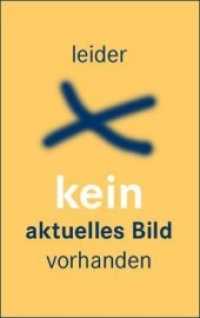- ホーム
- > 洋書
- > 英文書
- > Science / Mathematics
Full Description
Reverse engineering is widely practiced in the rubber industry. Companies routinely analyze competitors' products to gather information about specifications or compositions. In a competitive market, introducing new products with better features and at a faster pace is critical for any manufacturer. Reverse Engineering of Rubber Products: Concepts, Tools, and Techniques explains the principles and science behind rubber formulation development by reverse engineering methods. The book describes the tools and analytical techniques used to discover which materials and processes were used to produce a particular vulcanized rubber compound from a combination of raw rubber, chemicals, and pigments.
A Compendium of Chemical, Analytical, and Physical Test Methods
Organized into five chapters, the book first reviews the construction of compounding ingredients and formulations, from elastomers, fillers, and protective agents to vulcanizing chemicals and processing aids. It then discusses chemical and analytical methods, including infrared spectroscopy, thermal analysis, chromatography, and microscopy. It also examines physical test methods for visco-elastic behavior, heat aging, hardness, and other features. A chapter presents important reverse engineering concepts. In addition, the book includes a wide variety of case studies of formula reconstruction, covering large products such as tires and belts as well as smaller products like seals and hoses.
Get Practical Insights on Reverse Engineering from the Book's Case Studies
Combining scientific principles and practical advice, this book brings together helpful insights on reverse engineering in the rubber industry. It is an invaluable reference for scientists, engineers, and researchers who want to produce comparative benchmark information, discover formulations used throughout the industry, improve product performance, and shorten the product development cycle.
Contents
Compounding Ingredients and Formulation Construction: Introduction. Elastomers: Properties, Uses, and Vulcanization. Fillers. Protective Agents. Vulcanizing Chemicals. Processing Aids. Formula Construction. Principal Chemical and Analytical Methods Used in Reverse Engineering: Chemical Analysis. Infrared Spectroscopy. Thermal Analysis. Chromatography. Atomic Absorption Spectroscopy (AAS). Microscopy and Image Analysis. Mass Spectrometry. Principal Physical Test Methods: Introduction. Visco-Elastic Behavior. Elastic Modulus. Some Special Features of General Physical Tests. Reverse Engineering Concepts: General Concepts and Examples. Formula ReconstructionSpecific Example. Numerical Problem on Reverse Engineering. Formulation Reconstruction: Case Studies: Tire Tread Cap. Tire Sidewall. Tire Inner Liner. Heat Resistance Conveyor Belt Cover Compound. Fuel Hose Cover. Rubber Seal. V-Belt Compound. Rubber Covered Rolls. Rubber Part in Rubber-Metal Bonded Ring. Non-Black Elastic Tape. Rubber Diaphragm of Audio Speaker. Rubber Sealant. Bibliography. Appendices: Statistical Aspects of Chemical Analysis. Material Properties. Conversion Factors. Nuclear Magnetic Resonance (NMR) Spectroscopy. Glossary. Index.








